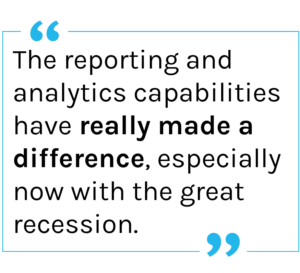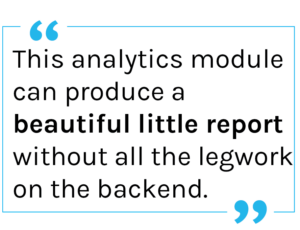Data insights and analytics are a hot topic at PeopleAdmin.
We’re focused on solutions that can bring you the information you need, when you need it. But what are some of the concrete benefits of data insights in your systems? How can data impact your institution and your team? Read on to hear from some of our customers about what data has done for their campuses.
Achieving results across departments
At St. Catherine University, Sarah Gasparini, Talent Manager, views data as the biggest benefit of PeopleAdmin. “Any institution with DEI initiatives has initiatives surrounding hiring. If we’re using the system as intended, we can see everyone who self-identifies as they apply and follow what happens during the application process,” said Sarah. “This data is incredibly beneficial to feed back to our customers across campus. We can have a conversation with them about their goal versus what we’re seeing. If you don’t have the data to back up those conversations, what can you really say? Now, we can pull reports and show users whether the data and the goal align. If they don’t, we’re able to discuss what behaviors should change to achieve results.”
Sarah also noted that historical information can be one of the best ways to understand trends and how to improve. “Paper systems, particularly in recruiting, are tough because records are only supposed to be kept for a year,” Sarah said. “When you have a secure system in place , you can look back at that data over the years to understand what a candidate pool looked like, and analyze what might be done differently.”
 Transparent, historical data makes a difference
Transparent, historical data makes a difference
Ann Robinson, HR Business Systems Analyst at Montana State University, leverages the historical data she finds through PeopleAdmin all the time. “The reporting and analytics capabilities have really made a difference, especially now with the great recession,” Anne said. “We’ve been able to look at our historical data—where are we underpaying, where are we not getting candidates, what is the actual applicant drop off over the course of a five-year window. We can see what is working and what isn’t, and where we’re getting improvements. There’s a real transparency for HR to be able to look at the data and look at the searches and make the judgement calls, or be able to easily see where we’re excelling and where we need to advance our processes.”
Centralized data
At Rutgers University, Hernández S. Hicks, Director of Talent Acquisition/ HR Consulting, is making the most of the data in the university’s systems to eliminate human error and manual data manipulation—and PeopleAdmin makes it easy. “Some tools can be so complex. PeopleAdmin makes it simple to grasp,” said Hernández. “Our data is in one, centralized place. It’s easy to access and gives us the intel we need to make better decisions for the organization. The setup makes it simple to know what you’re looking for, get the data at a glance, and get back to the job at hand.”
Answers when you need them – without specialized knowledge
The University of Arkansas had a lot of questions they wanted their data to answer—but they didn’t have the spare time to dig around for the insights they needed. That’s where Shannon Phillips, Compensation Analyst, says that PeopleAdmin came in. “It’s just so amazing to have the data right there at your fingertips, where you don’t have to go and spend three weeks massaging it to get it in a presentable format,” said Shannon. “There’s a lot of EEO and OEOC-type data. We have a whole department that does all of that reporting, so for them, it’s going to be amazing. They can pull it up and get the reports they need, which will help with compliance and reporting.”
Compensation Analyst, says that PeopleAdmin came in. “It’s just so amazing to have the data right there at your fingertips, where you don’t have to go and spend three weeks massaging it to get it in a presentable format,” said Shannon. “There’s a lot of EEO and OEOC-type data. We have a whole department that does all of that reporting, so for them, it’s going to be amazing. They can pull it up and get the reports they need, which will help with compliance and reporting.”
“Not every university has someone who can understand how to collect data and put it into a format that will be easily understood by upper leadership,” Shannon added. “But this analytics module can produce a beautiful little report without all the legwork on the backend. Anyone can use and understand their data in [Insights].
Final thoughts
Not sure what data can do for your institution? We’ve got the answers! Reach out to our solution experts to get the conversation going.